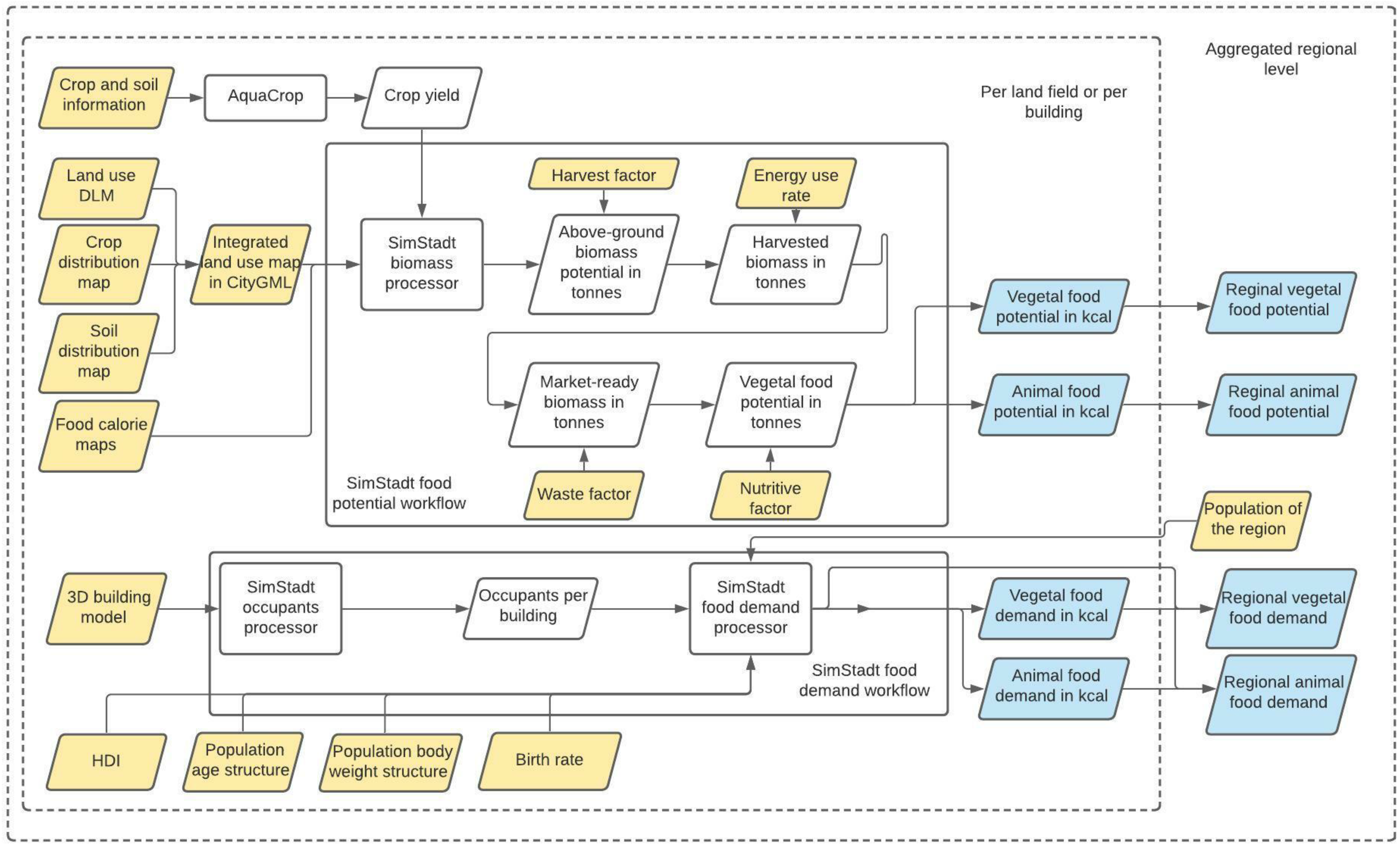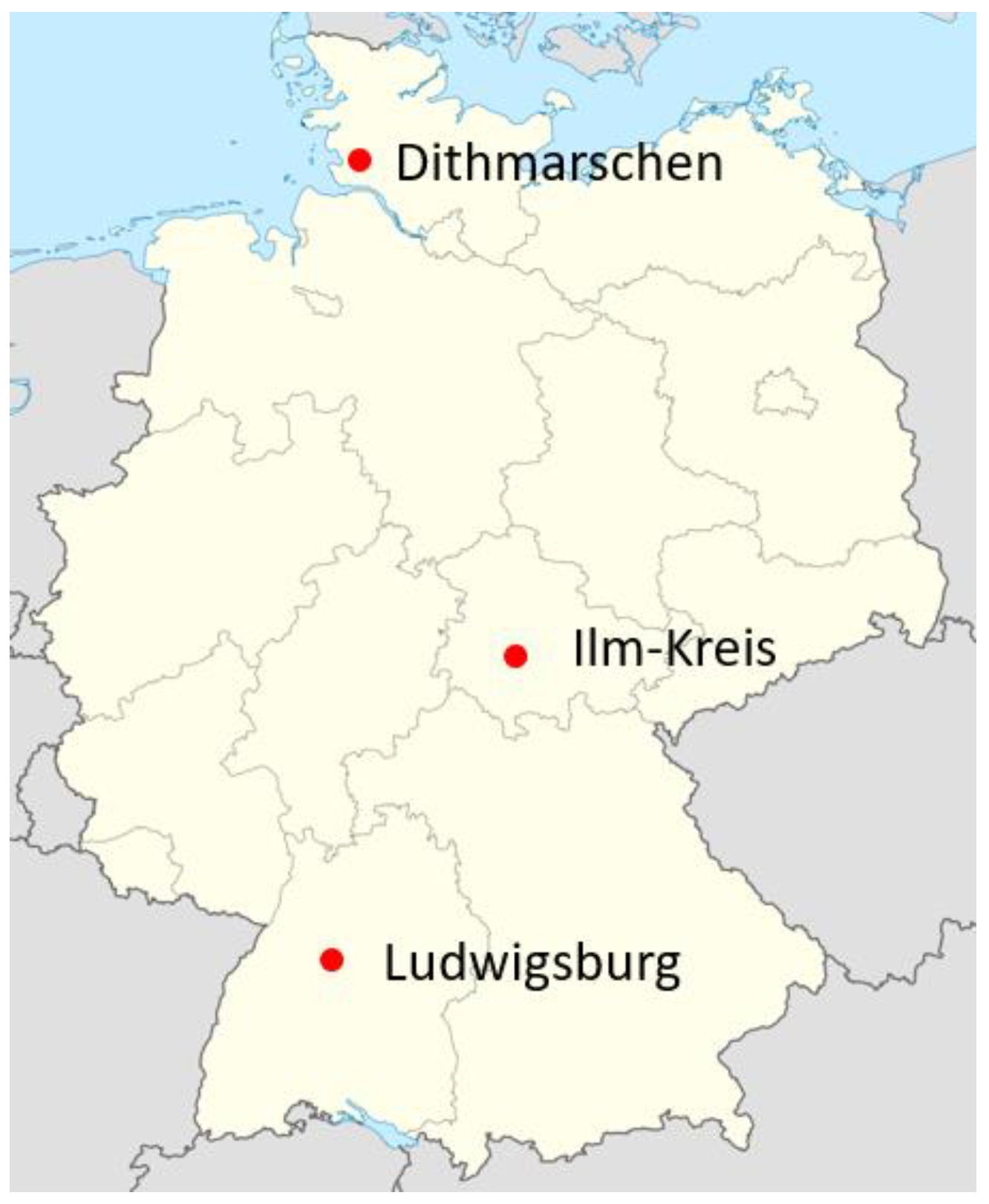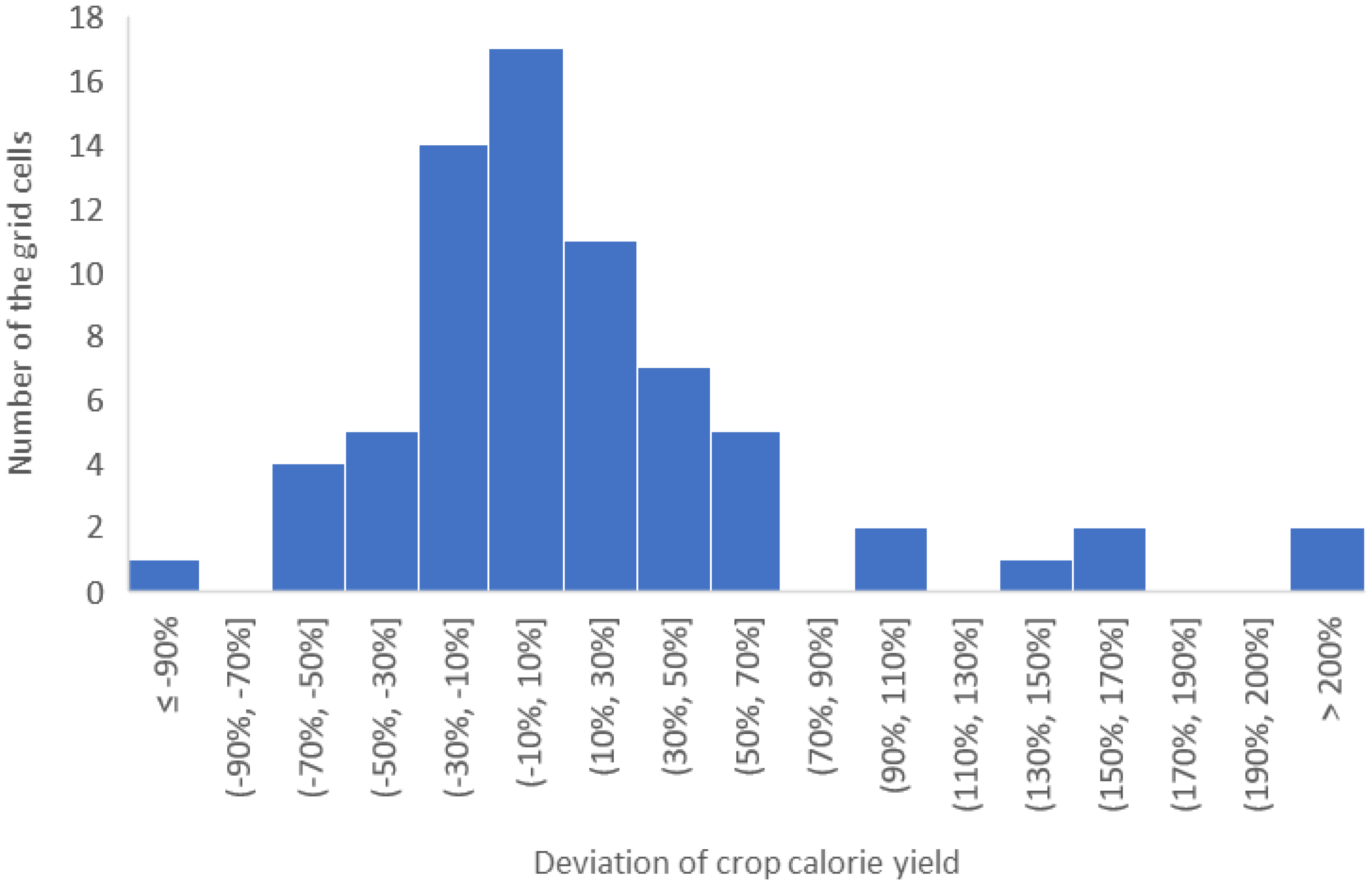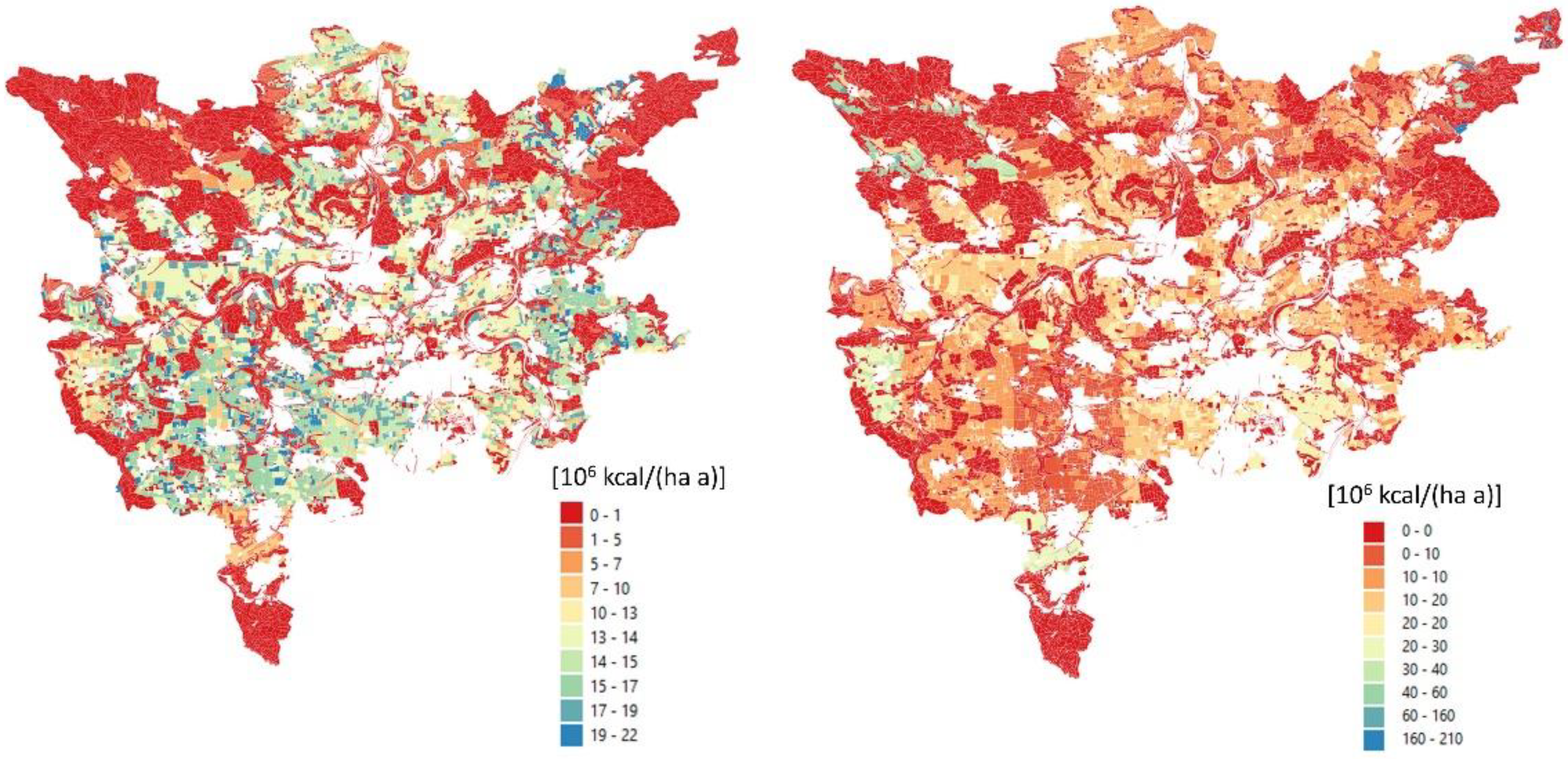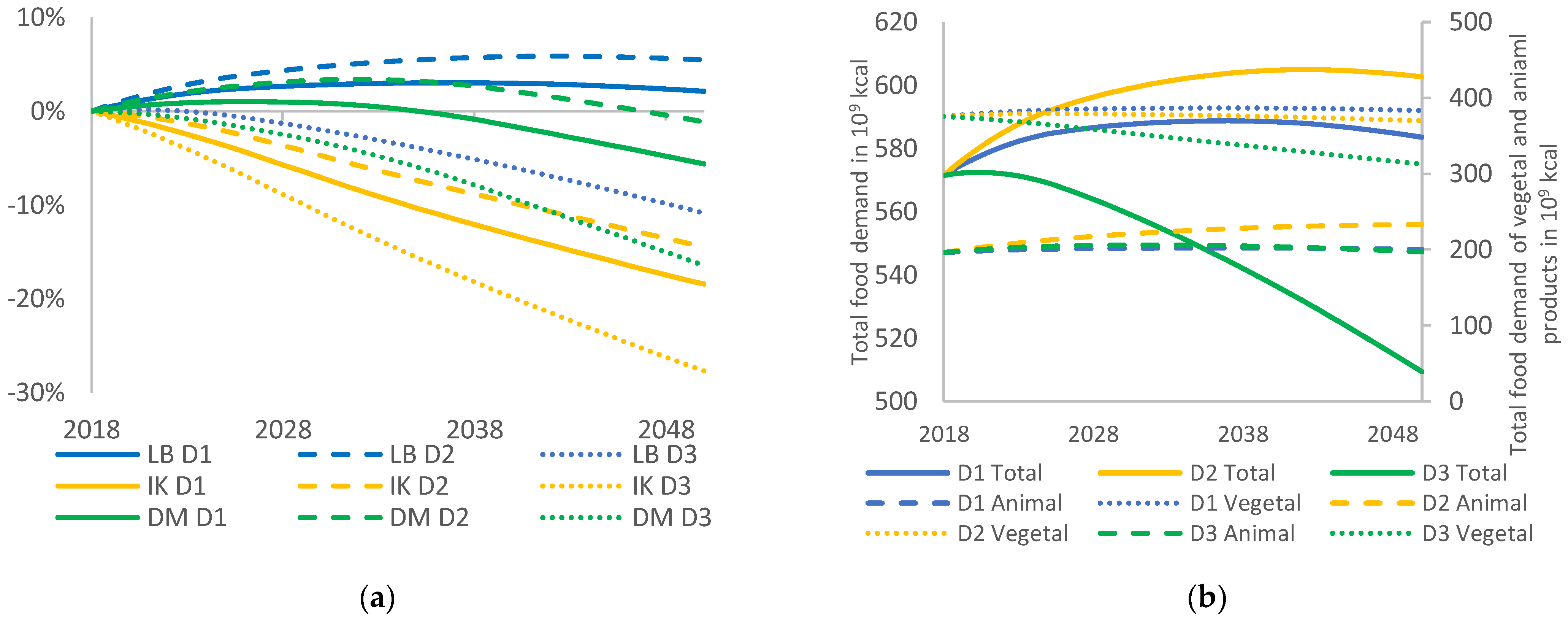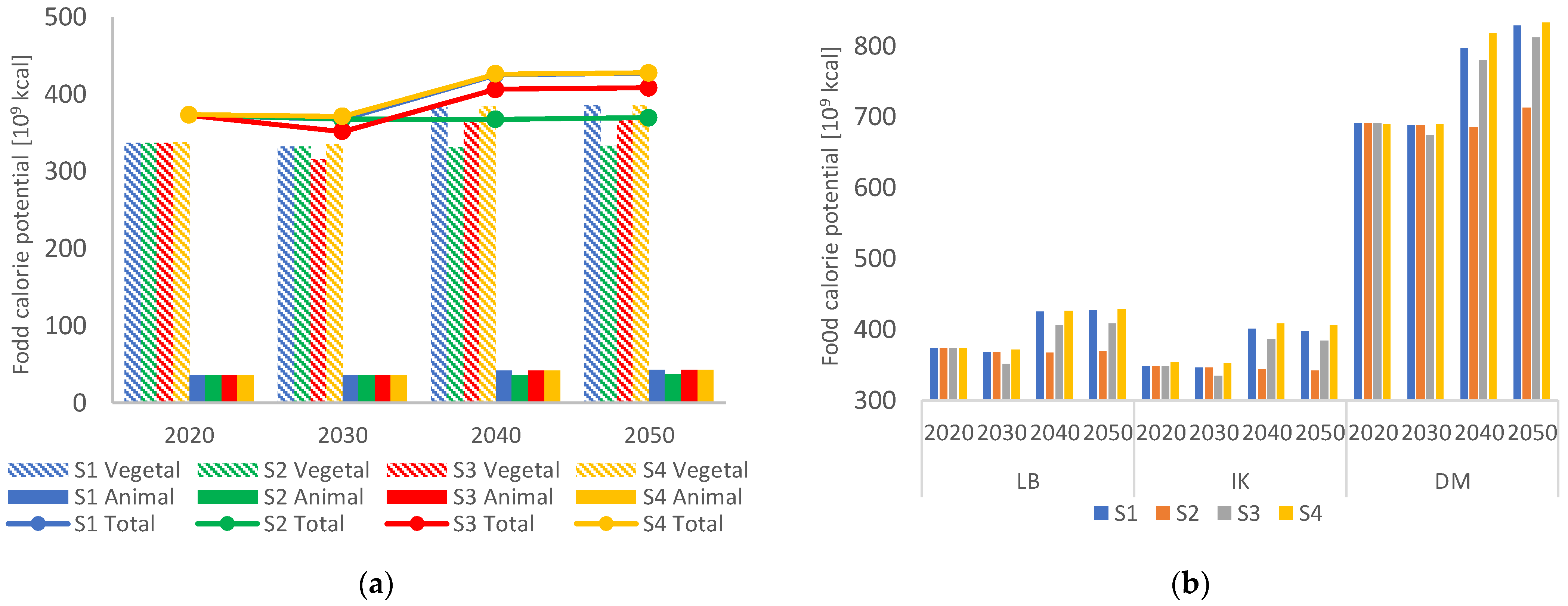1. Introduction
Human demands for the consumption of food, water, and energy are forecast to continue to rise in the coming decades [
1]. The challenge will be to meet these increasing demands sustainably across all dimensions [
2]. Given the fact that natural resources do not operate in isolation, a detailed recognition of their influences on one another is required [
3]. Therefore, a food potential simulation serves as an important element within the framework of the food-water-energy (FWE) nexus and allows us to, for example, study the impact of regional food production potentials on local bioenergy or free-field PV potential and vice versa.
Generally, a food system includes the elements of food production, harvesting, storage, processing, transportation, and consumption [
4]. Due to their complexity, the understanding of food system dynamics and the consequences of their rapid transformations is still limited [
5]. Indicators such as food security, biodiversity, food safety, or nutrition factors that quantify the performance of energy system are chosen by countries and organizations [
5]. In this paper, the consumers’ food demand, which includes the minimal nutritious demand, storage, and waste for end consumers, and food production potential, which represents the calorie amount of food potential stored in biomass, are emphasized and addressed.
On the demand side, the change of diet and its impact on cropland use were studied in [
6] and typical diets pattern and their projection are shown in [
7]. Both studies showed that the long-term nutrition state was improving, and food consumption patterns moved from low to higher calorie diets. With socio-economic development, population growth rates decreased and diets changed: typically, consumption of animal protein, vegetable oils, fruits, and vegetables increased, while starchy staples became less important [
6]. In food balance analysis, average statistical per-capita food availability values at a national level were usually used [
8]. To identify the influencing factors to food intake demand, the method introduced in [
9] provided the average per-capita food energy intake at the national level depending on the age, sex, country, birth rate, and population.
On the supply side, assessing yearly biomass mass potentials locally is the first step towards a regional food potential analysis. For such an analysis at the sub-country or country level, the most common way of acquiring crop production data is through statistical portals [
8,
10,
11,
12]. The advantage of this approach was its accuracy; however, statistical values are usually aggregated to the country or sub-country level and follow the administration boundary. Highly aggregated yield values, thus, lead to uncertainties if regional and sub-regional crop yield assessments are required, i.e., the statistical aggregated yield varies locally due to distinctly local climate and soil situations. To downscale the national yield data to a higher spatial resolution, a gridded crop yield raster map with a resolution of 5′ was adopted in [
13]. Still, the data was static from statistical sources without the possibility to study the influences of, e.g., climate change and irrigation. Moreover, food waste is not considered in this study. Rosenberg et al. simulated the potential changes for crops, only including wheat, rice, maize, and soybeans, caused by climate change at the global level using compatible crop models. The impacting factors included the current mix of rainfed and irrigated production, today’s crop varieties, nitrogen management, and agricultural soils. However, the method was site-specific and aggregated to the national level [
14].
Several studies analyzed the food inequality between food supply and consumption across countries and sub-regions adapting GIS (Geographic Information System) methods [
10,
15]. Merem et al. analyzed food security by presenting and comparing collected data with GIS methods at the national level. Without simulating socio-economic and natural environmental influences, the paper only presented grain food potential without distinguishing vegetable and animal food potential at the national aggregated level [
15]. Khushi et al. investigated how disaggregated data on food consumption, nutrient demand, and production of major commodities on a sub-national level could be interlinked in the GIS environment to spatially analyze food consumption inequalities [
10]. The food production was taken from statistical sources aggregated to the county (district) level. This restricts the approach to (i) a higher resolution, e.g., urban surroundings, and (ii) certain external environment changes, e.g., climate change. Furthermore, Beltran–Pena et al. performed an integrated, global assessment that considers a range of factors affecting future food production and demand until 2100 at the national level [
11]. Driven by its scale, highly aggregated values at the national level and assumptions were used, e.g., the per-capita calorie demand is constant for all scenarios and regions, and climate change effects are considered only for certain crop types.
A regional food potential simulation tool is thus missing, which: (i) simulates the food potential using a bottom-up approach based on a dynamic biomass yield simulator for all crop types, considering impact factors including local climate, crop type distribution, or soil texture distribution; (ii) can be applied to any chosen region without strictly following administrative boundaries at any level of scale, i.e., from community to county to federal state; (iii) builds on commonly available GIS data models for both potential and demand analysis; (iv) is integrated into an energy-water simulation platform [
16], that can simulate the roof PV potential [
17], heat demand [
17], electricity profile [
18], water demand [
19], and bioenergy [
20] to complete the workflow sets for assessing FWE nexus effects. This allows studies of trade-offs between local energy and food potentially on the same land areas by also considering constraints of local water resources—even more so after the workflows that assess free land PV and wind onshore potentials are finished.
The objective of this paper was to investigate regional food consumption and production potential with a high geographical resolution, building on commonly available digital landscape models as a key input on the supply side, as well as on the demand side if population data is missing. The goal was not to rival more specialized tools that focus on food demand or supply, but to extend an existing water-energy simulation platform with a reasonably accurate workflow for assessing regional food supply-demand balances and to thus be able to investigate trade-offs along the food-water-energy nexus at any regional scale. To give an example, a combination of the workflows allows us to assess the energetic benefits of applying wind onshore or free-field PV to varying degrees on different forms of land, and their impacts on irrigation water demand and local food production potential.
Regional food potential was simulated by extending an existing GIS-based biomass workflow based on food-related GIS data, e.g., crop calorie value, food waste, and animal product amounts (
Section 2.1). Regional food demands are simulated by multiplying occupant numbers based on CityGML (City Geography Markup Language) 3D building objects and per-capita calorie demand considering several socio-economic indicators (
Section 2.2). Three representative case study counties in Germany were chosen (
Section 2.3) and used for validation (
Section 2.4) and sensitivity analysis (
Section 2.5).
2. Materials and Methods
Figure 1 gives an overview of the input (yellow) and output (blue) data and methods used in this study. SimStadt, which has been under constant development at HFT Stuttgart since 2012 [
16], comprises a modular workflow management, with each workflow serving a specific purpose. To date, it can assess building-related demands (cooling and heating [
21,
22], residential electricity [
18], water [
19]) and renewable energy potential (rooftop photovoltaics [
17] and biomass [
20,
23]) on a single-building or single-field level using 3D city models or digital landscape models in the CityGML format. CityGML is an open standardized data model and exchange format to store digital 3D models of cities and landscapes [
24]. The biomass workflow which integrates the dynamic yield simulation tool AquaCrop [
25] applies a bottom-up approach to simulate the biomass yield in weight as well as the technical bioenergy potential for each land polygon covered with biomass. This biomass workflow is used as a basis for the newly-established food potential workflow.
Table 1 shows the (spatial) resolution and the sources of the input data. The topographic inputs include land use, crop distribution, a soil distribution map, and a food calorie map. The land use map consists of Digital Landscape Model (DLM) data from Germany’s Official Real Property Cadaster Information System (ALKIS) [
26]. The DLM map consists of several object types, including building, waterbody, vegetation, or transportation. Since the land area dedicated to transportation purposes is stored as a line plus a buffer width, it can overlap with the vegetation layer, and the shared part of the vegetation layer needs to be cut out to avoid its inflation. DLM data accurately indicated the boundary and main usage of each land polygon. However, the specific crop type growing on polygons classified as agricultural land was missing. To fill this gap, the DLM data was combined with satellite data on crop types distribution from [
27]. Plant-soil relationships in the surface soil layer affect crop productivity [
28]. For this, a soil map for Germany from the Federal Institute for Geosciences and Natural Resources (BGR) was adopted. This map shows the distribution of typical soil types in the topsoils.
On top of these maps, climate data (precipitation, atmospheric temperature, and irradiance) for current and predicted situations were taken from Meteonorm [
32]. The climatic data is available in hourly resolution for a chosen year. AquaCrop simulates the yields of all possible crops on all possible soil for biomass processors to use.
With the above-mentioned integrated land use maps, including information on land use, crop distribution, soil distribution, and climatic data, the biomass potential in weight was calculated with a single land polygon resolution. On top of this, food calorie maps from Pradhan et al. provide information and a global gridded map on a crop’s calorific production that is used as animal feedstock (FC), a crop’s calorie production itself (CP), and animal calorie production (AP) [
13]. Along with other additional input information, e.g., the nutritive factor that converts food weight into calorie values, the newly method assesses the annual vegetal and animal food potential in calorie values for each land polygon. This information can be aggregated to a regional level.
On the demand side, the Human Development Index (HDI), a population’s age structure distribution, and the bodyweight of different age groups are the parameters that correlate strongly with current and future food calorie demand per capita [
7]. If the food demand per building is required, or the study region is aligned with the administration boundary, a 3D building model containing all buildings in a given region can serve as an input for the SimStadt building occupant workflow [
33] to estimate the population of the study region. However, food demand can also be assessed based on total population data, as is the case in this paper.
2.1. Food Calorie Potential
Data for animal feed, crop production, and animal production are typically provided in specific mass units, e.g., tonnes per hectare and year. Using nutritive factors [
29], data were converted into calorific units, e.g., kcal per hectare and year, to be able to compare between crops and aggregate values. The crop calorie production (
) was calculated according to Equation (1) below, using the simulated actual annual yield for a given crop (
) from SimStadt biomass processor, land field area (
), and nutritive factor (
) (see
Table S1 at Supplementary Data).
As the crop distribution map distinguished 9 food crop types (see
Table 2), we only considered these 9 crop types with calorie potential, neglecting other, non-food crops. The detailed method of actual yield simulation using SimStadt and AquaCrop is presented in [
20]. In [
20], fruit orchards and grapevine are only considered from an energetic perspective. For this paper, static statistical fruit yields from [
34] were adopted for assessing the food potential on top of the residue energy residue potential (See
Table S2 in supplementary data).
Pradhan et al. defined three food relevant parameters: (i) feed calorie for animals (FC) represents the amount of crop from agricultural land that serves as feedstock for animals; (ii) animal calorie production (AP) is the amount of calories of the animal products produced in the grid; (iii) crop calorie production (CP) is the amount of calories of the vegetal products produced in the grid [
13]. The corresponding exemplary maps at the global scale can be found in Figures 2 and 3 in [
13]. The study by Pradhan et al. generated three maps to show FC, AP, and CP individually, as well as two maps to connect these three parameters: (i) a map showing the ratio between AP and FC, and (ii) a map showing the ratio between FC and CP. By combining these two maps, the ratio between AP and CP was obtained. Along with the CP values calculated in Equation 1, the animal food calorie potential (AP) could be determined. The two maps with food calorie information were provided in a raster grid of 5′ resolution globally. We merged these two maps with the existing soil-crop-land use map. Since the soil-crop-land use map has a higher resolution, 79% of all the polygons are smaller than 30,000 m
2 while the two ratios are attached to each land-use polygon as extra attributes.
Furthermore, food waste rates from harvest to consumption (
) (see
Table S2 at Supplementary Data), and energetic use factors per crop (
), i.e., the share of a crop’s yield that is used purely energetically, were included to simulate the end vegetal calorie potential (
), i.e., the potential of market-ready vegetal products, based on Equation (2) and the end animal calorie potential (
), i.e., the potential of market-ready animal products, based on Equation (3). As no data is available on
ef per polygon or raster cell, the same energetic use factor was applied to all polygons.
As mentioned before, the total animal calorie potentials (
AP) are linked to the crop calorie potential (
CP) through the feed calorie for animals (
FC) in the same grid. Grassland has no vegetal calorie potential, since only crops which can be used by humans directly were considered. Consequently, there is no animal calorie potential on grasslands. However, grass is an important feedstock for ruminant animals [
35]. As all the land use polygons in the same food grid have the same AP-CP ratio and no animal calorie is excluded in the original map from [
13], the animal calorie potential of grassland is distributed equally to all agricultural polygons in the same grid.
2.2. Food Calorie Demand
The two major factors determining a human’s dietary energy requirements (DER) are the basal metabolic rate (BMR) and the physical activity level (PAL) [
9,
36]. BMR is the minimum amount of energy required for a human and depends on body weight, age, and sex [
9,
37], while PAL expresses a person’s daily physical activity, which depends on lifestyle [
9,
36]. The dietary energy requirements for: (i) adults above the age of 20; (ii) infants, children, and adolescents; (iii) and pregnant women were calculated with different methods, which are shown in detail in
supplementary Text S1. The method was taken from [
9] without differentiating the calorie demands of different foods, i.e., it gives only one average aggregated daily calorie demand value per capita. As statistical bodyweight data from [
38] is not differentiated between German federal states, the food calorie demand in this study was kept constant between states. Differences between regions stem from varying population growth [
39], birth rates [
40], and age distributions [
41].
After a per-capita DER value was calculated, this total amount was divided into vegetal and animal calories according to statistical vegetal-animal food consumption shares from FAO [
42] to align with the food calorie potential calculated in
Section 2.1. It has to be noted, however, that the DER is lower than actual food consumption because of food wastage and losses in the household, for example during storage, preparation, and cooking.
Temporal Diet Pattern Change
Previous research estimated future per capita food demands on a country level until 2050 based on an exponential relationship between per capita animal product intake and the Human Development Index (HDI) [
7]. Here, HDI was extrapolated with a logistic regression based on data from [
43]. Logistic regression was chosen because the HDI is bounded to values between 0 and 1 (with 1 being the highest attainable score), with countries with a high HDI evolving more slowly. Further, this asymptotic behavior suggests the existence of smooth development pathways [
43]. The logistic regression formula is shown in Equation (4)
where
t is a year, and
a and
b are the coefficients to fit available data. In this study, German federal states’ annual HDI values between 1990 and 2017 [
44] were used to derive a and b for each federal state. As an example, historical data and extrapolation values from 1990 until 2050 of the whole Germany are shown in
Figure 2. For 1990 to 2017, the coefficient of determination
between historical and calculated data is 0.99. The HDI of an individual federal state was interpolated to better reflect the local situation.
According to [
5], the amount of total calorie demand, animal products, sugar-sweeteners, vegetable oils, and vegetables has an exponential relationship with HDI. The relation between
, the number of calories per category
i [1000 kcal/cap/day], and the HDI can be expressed by Equation (5):
where
and
are the coefficients per category, whose values are shown in
Figure S6 and Table S7. The coefficient of determination
between HDI and total food calorie is 0.8, and the
between HDI and animal food calorie demand is 0.91 [
7].
By combing Equations (4) and (5), a dietary pattern change in terms of food calorie demand for different food categories could be expressed as a function of the year. This is because the values of Equations (4) and (5) show a strong correlation between variables, a reasonably strong linkage between a given year and the food demand pattern change of the existing history. Additionally, the uncertainty of future diet pattern changes, e.g., reduced animal product consumption due to increased awareness on its impact on animal well-being or the climate, was not considered. With enough confidence, we argue that this method can be used to predict food demand change if the future diet pattern follows past developments.
Regarding the population of a given region, population numbers were taken from the statistical census portal for study regions with clear administration boundaries [
41]. For regions where population data is not statistically available, e.g., randomly defined regions, the population can be simulated by a previously published method developed for SimStadt that calculates building occupant numbers for residential buildings based on high-resolution statistical census data and a 3D building model [
33].
2.3. Case Study Regions
Three case study regions (German “Landkreise” or counties) were chosen for validation as well as sensitivity analysis out of a total of 400 German counties because, firstly, county-wide land use, soil, and crop distribution data are available, secondly, they differ concerning their agricultural land use, and thirdly, they are located in different parts of Germany, with differing climates.
Sub-urban: Ludwigsburg, Baden-Wuerttemberg, Southern Germany
Forest dominant: Ilm-Kreis, Thuringia, Mid-Eastern Germany
Agriculture dominant: Dithmarschen, Schleswig-Holstein, North Germany
The choice of these counties thus reflects the diversity of German and to some extent more broadly typical northern European landscapes.
Table 3 provides key characteristics for each county and
Figure 3 shows the location of the counties within Germany.
2.4. Validation
2.4.1. Food Demand and Consumption
Table 4 illustrates per capita food consumption and demand. As mentioned in
Section 2.2, the amount of food consumption, i.e., the amount bought, is typically greater than physical food demand because of waste and storage. Data on food consumption is typically more easily available than the actual physical food demand of inhabitants [
42]. Moreover, the food calorie demand method by [
9] took the average PAL values of non-overweighted adults in the United States as a moderate PAL, but a PAL was not provided for other countries. Since this paper focused on case studies in Germany, a validation process was executed to improve accuracy by eliminating the errors introduced by food waste, storage, and PAL.
Body weight data and aggregated food demand for Germany are available for the years 2005, 2009, 2013, and 2017 [
38,
42]. These data were processed and listed in
Table 3. As the mean body weight increases, simulated food demand increases in line, from 2387 kcal/capita/day to 2415 kcal/capita/day. Statistical data confirms this trend. However, the differences between simulated food demand and statistical food consumption are 31–32% for all years. This indicates that because of food waste and differences in PAL between Germany and the USA, actual German food consumption is about 31% higher than the simulated DER. Food consumption was thus derived from the physical food demand based on Equation (6).
2.4.2. Food Potential
Statistical food calorie potential and demand are only available at the national level. To validate results at a regional level, the crop calorie potentials map (CP) by Pradhan et al. with resolution of 5 arc degrees was adopted [
13]. As validation reference, the gridded crop calorie potential map used downscaled data on simulated crop yields and area harvested from GAEZv3.0 for the year 2000 [
47], with no more recent updates available. Therefore, GAEZv3.0 estimated crop yields and area harvested in a grid cell for the year 2000 based on FAO agricultural production statistics from the FAO.
The proposed methodology of food potential simulation was validated in the three case study counties. The crop calorie potentials simulated by SimStadt and by Pradhan and GAEZ as references are listed in
Table 5. At the county level, the simulated results in our study varied from the results of Pradhan and GAEZ by −7%, 1%, and 26% in Ludwigsburg, Ilm-Kreis, and Dithmarschen, respectively.
As mentioned in
Section 2.1, the crop calorie potential map from Pradhan [
13] has a resolution of 5 arc degrees (around 6 km for German latitudes), which typically covers more than 150 land use polygons from the DLM integrated land use map used for crop calorie simulation in SimStadt: as an example,
Figure S6 in the supplementary data illustrates grid cells from [
13] and land use polygons in Ludwigsburg county. As
Figure 4 shows, 70% of the grid cells have a deviation of crop calorie potential between both approaches of −30% and 30%. Large deviations can be due to grid cells not fully within a studied county, and the calorie potential of the grid being concentrated in the area outside the boundary, i.e., the grid cell’s agricultural land lies primarily outside county boundaries and forests or urban areas can be found inside. See for example the grid cells along the left boundary in
Figure S6.
2.5. Sensitivity Analysis
We defined four cases to project food production (S) and three cases to project food consumption (D) from 2020 until 2050. Case S1 is the baseline on the production side, with climate change from 2020 to 2050 as included in Meteonorm data, the share of the organic farming area following historical growth rates, no artificial irrigation, and an energetic use factor of crops of zero after 2030 (Background: With the Renewable Energy Directive 2018/2001 (RED II), adopted in December 2018, the EU (European Union) is continuing to develop the political framework for the use of renewable energy sources in the transport sector for the period from 2021 to 2030 [
48], while first-generation bioethanol, i.e., ethanol from crops, will be phased out until 2030). In the case of S2, RED II was not considered, allowing the energetic use of certain crops. This scenario serves as a second base case, since it allows for easier comparison of results before 2030 and afterwards.
In S1, the share of organic farmland in Germany follows historical statistical data [
49] as shown in
Figure S1, when the ratio increased from 1.6% in 2002 to 9.1% in 2018. In S1, we thus applied a linear fit to the historical trend. The 2050 share of the organic farming area then reaches 16.7%. Organic farming here refers to a sustainable agricultural system respecting the environment and animal welfare, but also includes all other stages of the food supply chain. To assess an organic farming yield in detail as compared to conventional methods, an extensive simulation tool that considers agricultural systems holistically would have been needed [
50], which is beyond the scope of this study and the capabilities of the biomass simulation tool [
20,
51]. However, we examined the relative yield performance of organic and conventional farming systems globally and showed that organic farming land on average had 34% lower yields than conventional approaches in most comparable settings. Since the action plan for the development of EU organic farming aims to have at least 25% of EU agricultural land farmed organically by 2030 [
52], case S3 assumed this value for 2030 and followed the same absolute increment percentage as in case S1 between 2030 and 2050. Lastly, case S4 includes artificial irrigation. A crop’s irrigation demand was determined by the minimal amount of external water that has to remain in the root zone throughout the growing cycle so that the given water stress was maintained in the growing season. The higher the water stress level, the lower the amount of water that was allowed to stay in the soil [
20].
On the food demand side, D1 is the baseline case where the dietary pattern stays the same as in the year 2017, but changes in population change food demands. Population predictions were taken from [
53]. In addition to population change, diet changes were considered in D2, with the changes following the extrapolating and prediction method of food demands prediction shown in
Section 2.3. In D3, besides the population change and dietary demand change, a lower food waste rate was assumed: the EU and its member countries are committed to meeting the Sustainable Development Goal target to halve per capita food waste at the retail and consumer level by 2030 [
54]. Sector 2.3.1 suggested a gap between food consumption, i.e., the number of calories people buy, and DER, i.e., the minimal amount of calories to maintain physical activity, of 31%. Therefore, a smaller gap of 15% was assumed in D3. All cases are summarized in
Table 6.
4. Discussion
The methods and tools presented in this paper provide a bottom-up method to simulate the local food potential and demand mainly based on the CityGML geoinformatics data model in one single energy-water-food simulation platform. The presented method provides reasonably accurate results in terms of local food calorie potential. Due to a lack of statistical data on this scale, the method was validated against another model and showed differences in annual food potential of between −7% and 26%. These differences between annual crop calorie potential by the SimStadt-based method presented here and the gridded crop calorie potential by Pradhan et al. and GAEZv3.0 [
13] can be due to several methodical differences: (i) GAEZv3.0 took 23 major crop types both for rainfed and irrigated conditions into consideration while our method simulates all the agricultural land only with rainfed conditions; (ii) Pradhan et al. considered 19 food crop types, while only 10 food crop types are simulated in the proposed method because of limitations of applied crop distribution map by [
27]. Comparing results for all cells of 5 arc minutes by 5 arc minutes, 70% of the grids had deviations between −30% and 30%.
Restricting land used exclusively for energy crop production (see the change between cases S1 and S2) is the most effective way to increase annual food production potential. Climate change (see the development between 2020 and 2050 in case S2) in contrast generally reduces annual biomass yields by about 2%. However, higher annual average temperature and precipitation in Dithmarschen increased annual food potential by around 4%. In all regions and years, irrigation provided a potential increment of less than 2% (see case S4 compared to case S1) at the expense of irrigation water requirements of between 58 to 680 m3 per hectare and year. It has to be noticed that this method only simulates 10 main crop types, which are representative in bioenergy potential calculations. In reality, local food production varieties alone cannot fulfill people’s food demand, e.g., for exotic fruits. Only land-produced food potential was simulated without considering aquatic products in this study. Therefore, this method is limited to extensive food potential simulation, but its main goal is rather to simulate a relative loss of annual food production potential when using land fields more for energetic purposes, i.e., bioenergy, free land PV, or wind. With the result of this paper, low-yielded land can be identified and potentially converted into PV farms to reach more efficient land use.
The food demand assessments depend on two main parameters: the number of occupants and per capita food demand. A previous study [
33] simulated the household and occupants number of each building based on the 3D building CityGML data model and census data. Even though for this study only the total number of residents per county was relevant, it is thus also possible to simulate the food calorie potential of any neighborhood or sub-region, including across administrative boundaries or to-be-built areas where statistical values are not available. The per capita food calorie consumption, including food waste and storage, was estimated based on body weight, age distribution, PAL, and birth rate. Additionally, diet patterns were predicted according to HDI development until 2050. The simulation results show that in the Ludwigsburg region per capita, animal products demand was 990 kcal, and vegetal products demand was 1894 kcal per day in 2018. The amount of animal product consumption is expected to rise by 16% by 2050; meanwhile, 4% fewer vegetal products are expected to be consumed. The food waste by half can compensate for the increase in food demand. However, the food pattern prediction was based on historic data and behaviors. The trend of a vegetarian/vegan diet is not projected in this paper.
In Ludwigsburg, simulated local calorie potential covers 64% of simulated overall food demand, while animal calorie demand can be converted locally by less than 20% (Both with potential case S1 and demand case D2 in year 2020). In Ilm-Kreis and Dithmarschen, the respective ratios are 300/262% and 486/859%, respectively, reflecting the lower population density in Dithmarschen and the forested landscape in Ilm-Kreis. As can be seen from these numbers, and has been investigated in other works [
6], a vegetal-oriented diet needs less arable land compared to an animal-oriented diet. Switching to more vegetal diets would thus open up room for higher shares of organic farming with its reduced yields but positive environmental impacts.
